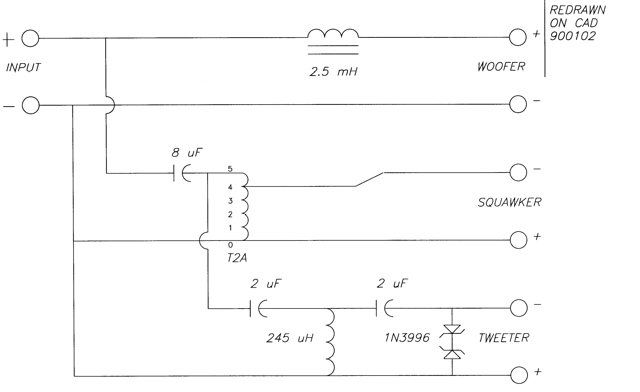-
Posts
26080 -
Joined
-
Days Won
9
Content Type
Forums
Events
Gallery
Everything posted by Deang
-

Crossover A Klipschorn cap replacement help
Deang replied to Aoran994's topic in Technical/Restorations
Roy gave UT permission to let me put T2A’s and T4A’s back into production. What are you trying to do? -

Crossover A Klipschorn cap replacement help
Deang replied to Aoran994's topic in Technical/Restorations
And @mboxler:-) -

Crossover A Klipschorn cap replacement help
Deang replied to Aoran994's topic in Technical/Restorations
Not according to Roy. -

Crossover A Klipschorn cap replacement help
Deang replied to Aoran994's topic in Technical/Restorations
We all need to find something else to talk about. How about that Baker Mayfield. -
No one ever said improvements can't be made. You presuppose that all mods are improvements.
-

Crossover A Klipschorn cap replacement help
Deang replied to Aoran994's topic in Technical/Restorations
In this case, a voltage transfer function, so yes. "The transfer function of a filter is the voltage amplitude at the output as a function of the frequency of a constant amplitude sine wave applied to the input." -

Crossover A Klipschorn cap replacement help
Deang replied to Aoran994's topic in Technical/Restorations
That was kind of the point of the discussion. It was in the earlier posts - comparing numbers from the data sheets and measurements for the different dielectrics. Sonicap and Dayton are polypropylene. Tecate are Mylar. Klipsch has been using Mylar since the early 70's. We are trying to show the OP, and anyone following along, how the different dielectric material impacts ESR, DF, etc. These measurements directly influence the voltage curves and transfer function. This much I learned directly from Roy, which is why he asked me to use Tecate, and to have Universal Transformer bring back the T2A, T4A autoformers and various coils. I even had to request a certain steel type for the laminations, as these also effect the voltages. Yes, it's audible, as Jim from JEM discovered, along with many others, who mostly just quietly fix things because they don't want to be caught in the middle of this quagmire. Klipsch doesn't make their engineering processes public, so we are often left to speculate. It's not a slam on Klipsch, just the reality of it. No one was being critical, so I don't understand the heavy hand. Well, I'm out. I no longer have the emotional bandwidth for this. -

Crossover A Klipschorn cap replacement help
Deang replied to Aoran994's topic in Technical/Restorations
Well, they were available to him when he had passives built for his Jubilee prototypes, and he didn’t use them. -

Crossover A Klipschorn cap replacement help
Deang replied to Aoran994's topic in Technical/Restorations
You are better off leaving them alone than doing that. -

Crossover A Klipschorn cap replacement help
Deang replied to Aoran994's topic in Technical/Restorations
The top tips up and you hear less bass. The sound thins out and is more forward. Easy to hear. I've been complaining about it for 15 years. -

Crossover A Klipschorn cap replacement help
Deang replied to Aoran994's topic in Technical/Restorations
A 2.0uF Sonicap measured .01 I can test at 100Hz, 120Hz, 1kHz, 10kHz, and 100kHz. I have several charts like those you posted, we have a good idea of what happens after 10kHz. -

Crossover A Klipschorn cap replacement help
Deang replied to Aoran994's topic in Technical/Restorations
Yes. I offered to take all of his money. He just has to decide if he wants to leave his networks as they are, recap them, or buy replacements. -
All of the excitement has moved to the various Klipsch Facebook pages where everyone is smarter than anyone that ever worked at Klipsch. I of course am a traitor "to the cause", and have traded in all of my high minded knowledge to worship Roy, lol!
-

Crossover A Klipschorn cap replacement help
Deang replied to Aoran994's topic in Technical/Restorations
Bypassing apparently has its use in power supply circuits, but in AC filters I'm pretty sure it's been debunked. As for ESR, the difference with these polyesters is 2/100's of an ohm. -

Crossover A Klipschorn cap replacement help
Deang replied to Aoran994's topic in Technical/Restorations
Paper in Oil capacitors are now found on eBay, and you would have to parallel quite a few to get the 13uF value. An acceptable substitute are the Klipsch OEM polyesters that are currently used in their current production loudspeakers. There are pinned posts at the top with resources, like schematics, and authorized vendors (like me) for parts and work. I have original OEM parts and could build you a new pair for $529.00. This would allow you to keep the originals intact for their historical value. -

Crossover A Klipschorn cap replacement help
Deang replied to Aoran994's topic in Technical/Restorations
Since ESR increases with frequency, it also acts as EQ in the circuit. The polypropylenes I've measured are all pretty much flat lining, as the chart shows. The Tecate polyesters I've measured so far are averaging .44 ohms at 1kHz. That's quite a bit of resistance in that circuit, and we haven't even addressed the autoformer and coils yet. Unless you're hearing is impaired, the increase in brightness is pretty noticeable, which is why I always knocked the midrange down a dB. I understand that's not the same as using the right parts. -

Crossover A Klipschorn cap replacement help
Deang replied to Aoran994's topic in Technical/Restorations
Hermetically sealed paper in oil. This is actually a good question for @JRH -
Wiggle/reseat the disconnects going to the drivers.
-
Ha ha, no, I am not the Klipsch network guy -- I've just been approved to do new builds and replace old parts. What is the history of the speaker. Was it overdriven?
-
Nah, just the part you need for the network to work as intended. Klipscheads: "We love our Klipsch stuff, it sounds great!" Also Klipscheads: "Klipsch is lying to us and holding us back with all of these crappy parts!" I have contributed to this mess and now the chickens have come home to roost.
-
Zoom zoom.
-
How do those crappy caps sound?









